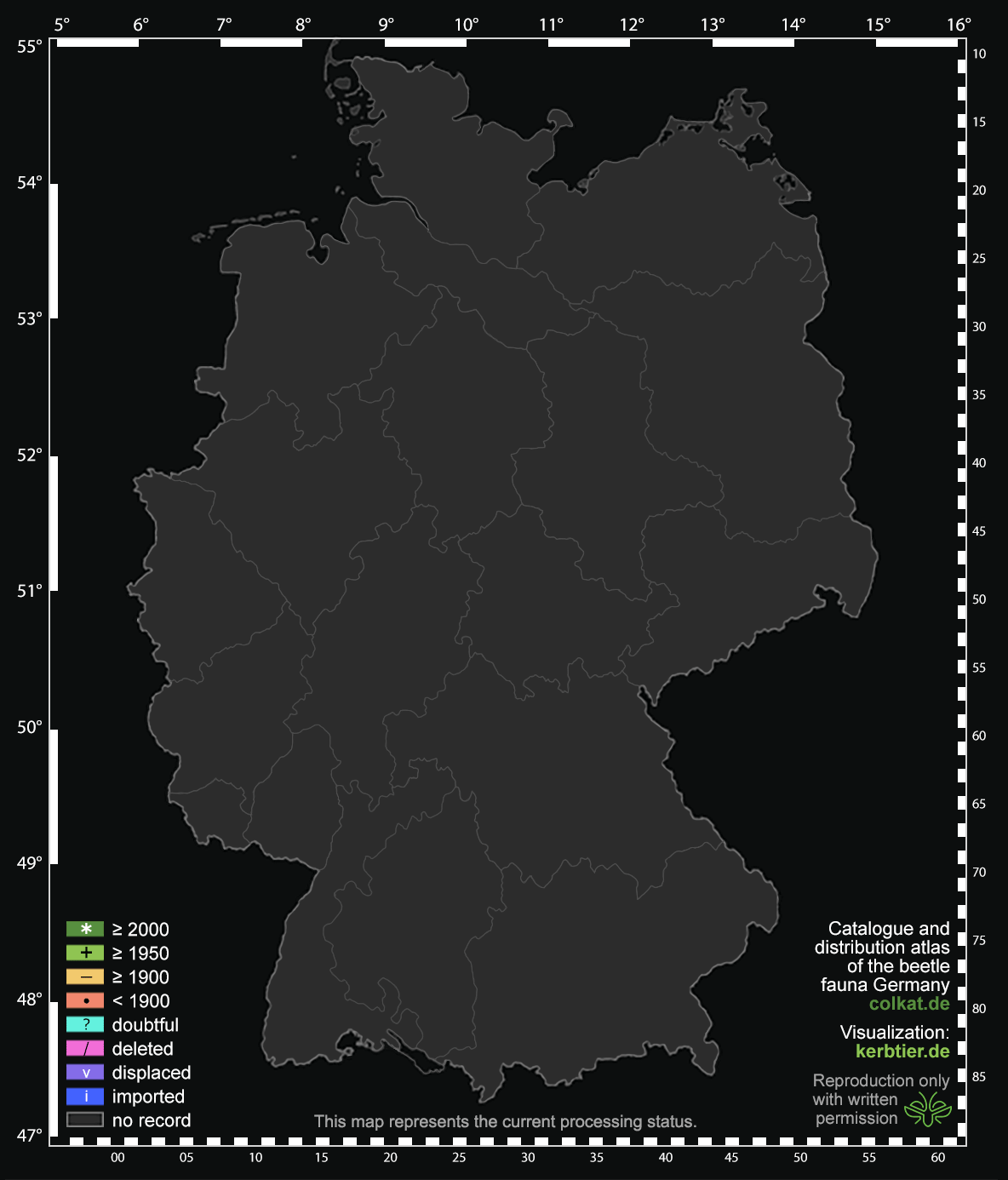View answered requests for beetle ID
|
|
On this page you can find photos submitted by users from the start in 2012 till the shutdown in 2023. If possible, the species are identified by the kerbtier.de ID team. Sometimes determination by photo only is impossible, in this case a hint on family and genus and potential species will be given.
|
|

|
|

|
|
|
|
Submitted by, on:
 22 22
 14 14

GerKlein  2013-05-11 10:42 2013-05-11 10:42

Country, map sheet, date (discovery):
 DE
DE
 5927 Schweinfurt (BN)
5927 Schweinfurt (BN)

 2013-05-10
2013-05-10
Request: 10.5.2013 am Waldrand
Hallo zusammen,
könnte das Phyllobius calcaratus sein?
Danke und schöne Grüße
GerKlein
Species, family:
 Phyllobius calcaratus
Phyllobius calcaratus
 Curculionidae
Curculionidae
Comment: Hallo GerKlein, yup, das sollte Phyllobius calcaratus sein. Nordafrika, Europa ohne den hohen Norden, bis Sibirien. An Stäuchern, Larve unterirdisch an Wurzeln. Häufig. LG, Christoph
Last edited by, on:  CB  2013-05-11 10:51 2013-05-11 10:51
|
|
|
|
|
|
|
|
Submitted by, on:
 348 348
 4 4

Karl  2013-05-11 10:22 2013-05-11 10:22

Country, map sheet, date (discovery):
 DE
DE
 5102 Herzogenrath (NO)
5102 Herzogenrath (NO)

 2013-05-08
2013-05-08
Request: Auf Weißdorn habe ich diesen ca. 8 mm Weichkäfer am 08.05.2013 gefunden, es müsste sich um Cantharis decipiens handeln. Vielen Dank
Species, family:
 Cantharis decipiens
Cantharis decipiens
 Cantharidae
Cantharidae
Comment: Hallo Karl, korrekt bestimmt als Cantharis decipiens. Eurytop, silvicol. In Wäldern, auf Waldwiesen und Lichtungen sowie an trockenen Waldrändern. Auf Blüten und Gebüsch. Mittel- und südliches Nordeuropa. LG, Christoph
Last edited by, on:  CB  2013-05-11 10:32 2013-05-11 10:32
|
|
|
|
Submitted by, on:
 346 346
 1 1

Karl  2013-05-11 10:16 2013-05-11 10:16

Country, map sheet, date (discovery):
 DE
DE
 5102 Herzogenrath (NO)
5102 Herzogenrath (NO)

 2013-04-30
2013-04-30
Request: Am 30.04.2013 habe ich an einen Baumpilz mehrere dieser ca. 2,5 mm Schwarzkäfer gefunden, meine Bestimmung Eledona agricola. Vielen Dank
Species, family:
 Eledona agricola
Eledona agricola
 Tenebrionidae
Tenebrionidae
Comment: Hallo Karl, korrekt bestimmt als Eledona agricola. Europa, Kaukasus, auch in Nordamerika. Mycetobiont, am Gemeinen Schwefelporling (Laetiporus sulphureus) an Salix, Populus, Quercus, Aesculus und Obstbäumen. LG, Christoph
Last edited by, on:  CB  2013-05-11 10:29 2013-05-11 10:29
|
|
|
|
Submitted by, on:
 8 8

gogo5760  2013-05-11 09:50 2013-05-11 09:50

Country, date (discovery):
 Austria
Austria

 No date of discovery found. Please contact webmaster! No date of discovery found. Please contact webmaster!
Request: Hi! Ich bins wieder! Die Schnellkäfer schaffen mich noch! Da hab ich noch einen vom Juli 2012, ganz in schwarz. Könnte das "Kibunea minuta" sein? Danke!
Species, family:
 Hemicrepidius
Hemicrepidius sp.
 Elateridae
Elateridae
Comment: Hallo Guntram, das ist Gattung Hemicrepidius, aber eine Bestimmung zur Art ist bei den beiden Arten H. niger und H. hirtus am dorsalen Foto nicht möglich. Die Unterscheidung erfolgt über die Form des Prosternalfortsatzes. LG, Christoph
Last edited by, on:  CB  2013-05-11 09:58 2013-05-11 09:58
|
|
|
|
Submitted by, on:
 7 7

gogo5760  2013-05-11 09:26 2013-05-11 09:26

Country, date (discovery):
 Austria
Austria

 No date of discovery found. Please contact webmaster! No date of discovery found. Please contact webmaster!
Request: Hi! Dieser grün- metallic-schillernde Blattkäfer ist nun auch schon wieder sehr häufig anzutreffen. Lässt er sich näher bestimmen? Danke!
Species, family:
 Oreina
Oreina sp.
 Chrysomelidae
Chrysomelidae
Comment: Hallo Guntram, der gehört zur Gattung Oreina. Allesamt montan bis alpin, und leider nach Foto nicht zur Art bestimmbar. LG, Christoph
Last edited by, on:  CB  2013-05-11 09:30 2013-05-11 09:30
|
|
|
|
Submitted by, on:
 6 6
 3 3

gogo5760  2013-05-11 08:53 2013-05-11 08:53

Country, date (discovery):
 Austria
Austria
 2013-05-08
2013-05-08
Request: Hallo! Gefunden am 8.5.2013 im Saalfeldner Becken (bayr.-österr. Grenzgebiet am südl. Rand der nördl. Kalkalpen) auf etwa 900m NN.
Erst dachte ich an "Athous bicolor", bin mir aber nicht mehr sicher. Danke im voraus!
Species, family:
 Athous vittatus
Athous vittatus
 Elateridae
Elateridae
Comment: Hallo Guntram, mit Deinem Zweifel hast Du recht: Es ist Athous vittatus. Von Europa bis Sibirien. In Laubwäldern, die Larve frißt an den Wurzeln von Laubbäumen. LG, Christoph
Last edited by, on:  CB  2013-05-11 09:28 2013-05-11 09:28
|
|
|
|
|
|
|
|
|
|
|
|

miraclecf  2013-05-10 22:46 2013-05-10 22:46

Country, map sheet, date (discovery):
 DE
DE
 3647 Königs Wusterhausen (BR)
3647 Königs Wusterhausen (BR)

 2013-05-10
2013-05-10
Request: 10.5.13, 3,5mm lang
Vorratskammer im Müsli
Schränken in den Nudeln, Keksen
Species, family:
 Oryzaephilus surinamensis
Oryzaephilus surinamensis
 Silvanidae
Silvanidae
Comment: Hallo miraclecf, bei diesem Tierchen handelt es sich um Oryzaephilus surinamensis. Es gibt noch eine ähnliche Schwesterart, O. mercator. Man unterscheidet die beiden an der Länge der Schläfen. Kulturfolger, Kosmopolit. Als Sekundärschädling in Vorräten, z.B. Getreiden, Mehl und Nüssen. Dort vor allem räuberisch, d.h. sie machen Jagd auf die meist bereits vorhandenen Primärschädlinge. Befallene Güter (Getreide, Müsli, Mehl, Nüsse, Kekse etc.) restlos entsorgen, Schrank auswischen und der Spuk ist vorbei. LG, Christoph
Last edited by, on:  CB  2013-05-10 23:20 2013-05-10 23:20
|
|
|
|
Submitted by, on:
 4 4
 2 2

gogo5760  2013-05-10 21:25 2013-05-10 21:25

Country, date (discovery):
 Austria
Austria

 No date of discovery found. Please contact webmaster! No date of discovery found. Please contact webmaster!
Request: Hallo! Dieses Bild entstand bereits im Juli 2012 und wurde auf einer Wiese im Saalfeldner Becken (bayr.-österr. Grenzgebiet) gemacht. Ich denke ein Scheinbockkäfer(Oedemeridae), aber welcher?
Species, family:
 Omalisus fontisbellaquaei
Omalisus fontisbellaquaei
 Omalisidae
Omalisidae
Comment: Hallo Guntram, der gehört in die kleine Familie Omalisidae, mit weltweit gerade mal 8 Arten, davon eine in Deutschland. Es ist Omalisus fontisbellaquaei. Die schön roten Exemplare kommen nach meiner Erfahrung in den wärmeren Lagen der Ebene vor. In den collinen und montanen Lagen findet man zunehmend auch rein schwarze. Mittel- und stellenweise Südeuropa, bis Westrussland. LG, Christoph
Last edited by, on:  CB  2013-05-10 21:29 2013-05-10 21:29
|
|
|
|
Submitted by, on:
 14 14
 2 2

Pia  2013-05-10 21:12 2013-05-10 21:12

Country, date (discovery):
 Switzerland
Switzerland
 2013-05-09
2013-05-09
Request: Hallo, CH- Wattwil 09.05.13. Fundort: Brunnentrog, Grösse: 6mm.
Mit diesen Grabschaufeln - könnte es Clivina fossor sein? Vielen Dank u.LG.
Species, family:
 Clivina fossor
Clivina fossor
 Carabidae
Carabidae
Comment: Hallo Pia, ja, mit dem gleichfarbigen Halsschild und Flügeldecken sollte es Clivina fossor sein - Clivina collaris ist deutlich zweifarbig. Daneben gibt es mit C. ypsilon noch eine dritte Art in Mitteleuropa (Niederösterreich, Tschechien), die aber ausgeschlossen werden kann. Holarktisch verbreitet. LG, Christoph
Last edited by, on:  CB  2013-05-10 21:22 2013-05-10 21:22
|
|
|
|
Submitted by, on:
 12 12

João Nunes  2013-05-10 20:51 2013-05-10 20:51

Country, date (discovery):
 Portugal
Portugal
 2013-05-10
2013-05-10
Request: Porto, Portugal
10/5/13
Species, family:
 Psilothrix
Psilothrix sp.
 Melyridae
Melyridae
Comment: Oi João, this is a representative of genus Psilothrix. To the best of my knowledge there are the species present in Portugal, P. viridicoeruleus and P. illustris. They are distinguished by the color of the pubescence of the elytra: black in P. viridicoeruleus and yellow in illustris. This is not feasible with the photo at hand, so I leave it with Psilothrix sp. Best regards, Christoph
Last edited by, on:  CB  2013-05-10 21:15 2013-05-10 21:15
|
|
|
|
Submitted by, on:
 3 3
 13 13

gogo5760  2013-05-10 20:46 2013-05-10 20:46

Country, date (discovery):
 Austria
Austria
 2013-05-09
2013-05-09
Request: diesen bläulichen Schnellkäfer fand ich gestern auf einem Blatt unserer Buchenhecke (Saalfeldner Becken im bayrisch-österreichischen Grenzgebiet auf ca. 800m NN). ?
Species, family:
 Athous haemorrhoidalis
Athous haemorrhoidalis
 Elateridae
Elateridae
Comment: Hallo Guntram, ich denke der blaue Schimmer ist nur ein Artefakt, verursacht durch die Umstände der Belichtung. Das abgelichtete Tier sollte meiner Meinung nach ein Athous haemorrhoidalis sein. Diese Art mutiert hier so langsam zum Dauerbrenner ;-). LG, Christoph
Last edited by, on:  CB  2013-05-10 20:56 2013-05-10 20:56
|
|
|
|
Submitted by, on:
 15 15

Johan  2013-05-10 08:18 2013-05-10 08:18

Country, date (discovery):
 Belgium
Belgium
 2013-05-09
2013-05-09
Request: Heverlee, Belgium, 9.5.2013, estimated size:~6 mm; on common hazel, swift, and flew away before I could make closer pictures. Looks like Elodes minuta, but I remain with doubts. Thanks for help!
Species, family:
 Elodes
Elodes sp.
 Scirtidae
Scirtidae
Comment: Hi Johan, this is a representative of the genus Elodes, and there one of the 5 species of the so called minuta group. Unfortunately, the species in this group can be only distinguished by dissection and examination of the aedoeagus of the male. Regards, Christoph
Last edited by, on:  CB  2013-05-10 20:54 2013-05-10 20:54
|
|
|
|
Submitted by, on:
 79 79
 2 2

Inja  2013-05-10 10:14 2013-05-10 10:14

Country, date (discovery):
 Poland
Poland
 2013-05-09
2013-05-09
Request: Found yesterday (09.05.2013) in Bielsko-Biala (South Poland). Decidouos forest. Very small :)
Species, family:
 Protapion fulvipes
Protapion fulvipes
 Apionidae
Apionidae
Comment: Hi Inja, this is a representative of genus Protapion. There are two species that are likely, P. fulvipes and P. nigritarse. I would think it's the first one, due to the club of the antenna, which is not clearly separated from the middle articles of the antenna (in terms of width). With some uncertainty. Regards, Christoph
Last edited by, on:  CB  2013-05-10 20:46 2013-05-10 20:46
|
|
|
|
Submitted by, on:
 77 77
 12 12

Inja  2013-05-10 10:12 2013-05-10 10:12

Country, date (discovery):
 Poland
Poland
 2013-05-09
2013-05-09
Request: Found yesterday (09.05.2013) in Bielsko-Biala (South Poland). Decidouos forest.
Species, family:
 Phyllobius calcaratus
Phyllobius calcaratus
 Curculionidae
Curculionidae
Comment: Hi Inja, that should be another Phyllobius calcaratus (nowadays P. glaucus). Common species on deciduous trees and shrubs. Regards, Christoph
Last edited by, on:  CB  2013-05-10 20:33 2013-05-10 20:33
|
|
|
|
|
|
|
|
Submitted by, on:
 92 92
 1 1

Inja  2013-05-10 10:26 2013-05-10 10:26

Country, date (discovery):
 Poland
Poland
 2013-05-09
2013-05-09
Request: Found yesterday (09.05.2013) in Bielsko-Biala (South Poland). Decidouos forest.
Species, family:
 Prasocuris marginella
Prasocuris marginella
 Chrysomelidae
Chrysomelidae
Comment: Hi Inja, if I'm not toally out of mind, that's Prasocuris marginella. I leave it for the others to check it. Regards, Klaas
Last edited by, on:  KR  2013-05-10 20:18 2013-05-10 20:18
|
|
|
|
Submitted by, on:
 9 9

Urs  2013-05-10 10:01 2013-05-10 10:01

Country, date (discovery):
 Switzerland
Switzerland
 2013-05-09
2013-05-09
Request: Diese ca.1,8mm grossen Käfer finde ich zurzeit häufig im Garten auf niederen Pflanzen. Bevorzugt auf Natterkopf (Echium vulgare).Ich vermute, er gehört auch zu den Halticinae und kann nicht bis auf die Art nach Fotos bestimmt werden,vielleicht bis zur Gattung?? Vielen Dank LG Urs
Species, family:
 Longitarsus
Longitarsus sp.
 Chrysomelidae
Chrysomelidae
Comment: Hallo Urs, der sollte zur Gattung Longitarsus gehören. Auf Echium treiben sich etliche der Arten herum und Longitarsus bestimmen ich - bis auf ganz wenige Ausnahmen - am Foto definitiv nicht. Grüße, Christoph
Last edited by, on:  CB  2013-05-10 20:17 2013-05-10 20:17
|
|
|
|

Justus  2013-05-10 20:09 2013-05-10 20:09

Country, map sheet, date (discovery):
 DE
DE
 2237 Gr. Raden (MV)
2237 Gr. Raden (MV)

 2013-05-10
2013-05-10
Request: Fundort sonniger Hang Freilichtmuseum Raden am 10. Mai 2013
Species, family:
 Meloe proscarabaeus
Meloe proscarabaeus
 Meloidae
Meloidae
Comment: Hallo Justus, anhand der leicht geknickten und im Knick verdickten Fühler sowie dem kräftig punktierten Kopf und Halsschild als Weibchen von Meloe proscarabaeus zu erkennen. Aktivitätszeit von Anfang März bis Juni, mit Hauptzeit von April bis Mai. Paläarktisch verbreitet, Nordafrika, Europa, bis Ostasien und Japan. Bei uns hier in D die häufigste Meloe-Art. LG, Christoph
Last edited by, on:  CB  2013-05-10 20:11 2013-05-10 20:11
|
|
|
|
Submitted by, on:
 117 117
 6 6

cilko  2013-05-10 20:07 2013-05-10 20:07

Country, date (discovery):
 Slovakia
Slovakia
 2013-05-10
2013-05-10
Request: Hi, size 3mm, 10.5.2013, Slovakia
Species, family:
 Furcipus rectirostris
Furcipus rectirostris
 Curculionidae
Curculionidae
Comment: Hi Cilko, that's again Furcipus rectirostris, but the current name is Anthonomus rectirostris, because Furcipus is put as subgenus to Anthonomus. Regards, Klaas
Last edited by, on:  KR  2013-05-10 20:11 2013-05-10 20:11
|
|
|
|
Submitted by, on:
 46 46
 2 2

Mr. Pampa  2013-05-10 19:57 2013-05-10 19:57

Country, date (discovery):
 Denmark
Denmark
 2013-05-10
2013-05-10
Request: Dänemark, Sydals, bei Sønderborg, 10. Mai 2013, entdeckt nach Gang durch den Buchenhochwald zu Hause auf dem Tisch. Zweites Foto auf Maßband (also 2,5 mm).
Ich denke, es ist Rhynchaenus fagi, der der Buchenspringrüssler. Richtig? Bitte ID - danke
Species, family:
 Rhynchaenus fagi
Rhynchaenus fagi
 Curculionidae
Curculionidae
Comment: Hallo Mr. Pampa, korrekt bestimmt als Rhynchaenus fagi. Inzwischen wird er in die Gattung Orchestes gestellt. In Laub- und Mischwäldern an Rotbuche. Sehr häufig. In Europa ohne die iberische Halbinsel. LG, Christoph PS: Bei dem Foto auf dem Maßband sollte man die Gedankenblase des Käfers sehen: "Scheiß Käferspinner!". ;-D LG, Christoph
Last edited by, on:  CB  2013-05-10 20:09 2013-05-10 20:09
|
|
|
|

gogo5760  2013-05-10 12:20 2013-05-10 12:20

Country, date (discovery):
 Austria
Austria

 No date of discovery found. Please contact webmaster! No date of discovery found. Please contact webmaster!
Request: im Bereich der nördlichen Kalkalpen im Saalfeldner Becken (Österr., Salzburg, Pinzgau) auf ca 800m NN. Etliche Exemplare auf Brennessel
Species, family:
 Chrysolina fastuosa
Chrysolina fastuosa
 Chrysomelidae
Chrysomelidae
Comment: Moin Guntram, die haben sich in der Pflanze vertan, gehören sie doch auf Hohlzahn. Du hast eine ausgesprochen hübsche Farbvariante (habe ich so noch nie gesehen) von Chrysolina fastuosa gefunden. Liebe Grüße, klaas
Last edited by, on:  KR  2013-05-10 20:08 2013-05-10 20:08
|
|
|
|
Submitted by, on:
 85 85

Inja  2013-05-10 10:21 2013-05-10 10:21

Country, date (discovery):
 Poland
Poland
 2013-05-09
2013-05-09
Request: Found yesterday (09.05.2013) in Bielsko-Biala (South Poland). Decidouos forest.
Species, family:
 Oedemera
Oedemera sp.
 Oedemeridae
Oedemeridae
Comment: Hi Inja, that's a representative of the Oedemera lurida complex, consisting of O. lurida, O.virescens, O. monticola and (not in Germany, but Poland) O. subrobusta. I don't dare to give a det to species level here. O. lurida is excluded though - thickened rear femora. Regards, Christoph
Last edited by, on:  CB  2013-05-10 19:27 2013-05-10 19:27
|
|
|
|




